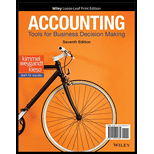
EBK ACCOUNTING:TOOLS F/BUSINESS...
7th Edition
ISBN: 9781119494799
Author: Kimmel
Publisher: WILEY
expand_more
expand_more
format_list_bulleted
Question
Chapter 20, Problem 10E
(a)
To determine
Calculate the total net income if all the products are sold at the split-off point.
(b)
To determine
Calculate the total net income if all the products are sold after further processing.
(c)
To determine
Calculate the products to be sold at the split-off point, and the products to be processed further, by using incremental analysis.
(d)
To determine
Calculate the total net income using the results from (c), and to explain the reason behind the net income being different from the net income determined in (b).
Expert Solution & Answer
Trending nowThis is a popular solution!

Students have asked these similar questions
AMC enterprises is preparing it's cash budget got October.
I need help with accounting question
Actual sale ? Financial accounting
Chapter 20 Solutions
EBK ACCOUNTING:TOOLS F/BUSINESS...
Ch. 20 - Prob. 1QCh. 20 - Prob. 2QCh. 20 - Prob. 3QCh. 20 - Prob. 4QCh. 20 - Prob. 5QCh. 20 - Prob. 6QCh. 20 - Prob. 7QCh. 20 - Prob. 8QCh. 20 - Prob. 9QCh. 20 - Prob. 10Q
Ch. 20 - Prob. 11QCh. 20 - Prob. 12QCh. 20 - Prob. 1BECh. 20 - Prob. 2BECh. 20 - Prob. 3BECh. 20 - Prob. 4BECh. 20 - Prob. 5BECh. 20 - Prob. 6BECh. 20 - Prob. 7BECh. 20 - Prob. 8BECh. 20 - Prob. 1DIECh. 20 - Prob. 2DIECh. 20 - Prob. 3DIECh. 20 - Prob. 4DIECh. 20 - Prob. 5DIECh. 20 - Prob. 6DIECh. 20 - Prob. 1ECh. 20 - Prob. 2ECh. 20 - Prob. 3ECh. 20 - Prob. 4ECh. 20 - Prob. 5ECh. 20 - Prob. 6ECh. 20 - Prob. 7ECh. 20 - Prob. 8ECh. 20 - Prob. 9ECh. 20 - Prob. 10ECh. 20 - Prob. 11ECh. 20 - Prob. 12ECh. 20 - Prob. 13ECh. 20 - Prob. 14ECh. 20 - Prob. 15ECh. 20 - Prob. 16ECh. 20 - Prob. 17ECh. 20 - Prob. 18ECh. 20 - Prob. 1APCh. 20 - Prob. 2APCh. 20 - Prob. 3APCh. 20 - Prob. 4APCh. 20 - Prob. 5APCh. 20 - Prob. 20CDCh. 20 - Prob. 1EYCTCh. 20 - Prob. 2EYCTCh. 20 - Prob. 3EYCTCh. 20 - Prob. 5EYCTCh. 20 - Prob. 6EYCTCh. 20 - Prob. 7EYCTCh. 20 - Prob. 8EYCT
Knowledge Booster
Similar questions
- Fred needs $65,000 after tax in retirement income. If his expected average tax rate will be 21% and his marginal will be 27%, how much does he need before tax? a. $89,041. b. $82,278. c. $78,650. d. None of the above. e. $82,550.arrow_forwardPlease explain the solution to this general accounting problem using the correct accounting principles.arrow_forwardCould you explain the steps for solving this general accounting question accurately?arrow_forward
arrow_back_ios
SEE MORE QUESTIONS
arrow_forward_ios
Recommended textbooks for you

 AccountingAccountingISBN:9781337272094Author:WARREN, Carl S., Reeve, James M., Duchac, Jonathan E.Publisher:Cengage Learning,
AccountingAccountingISBN:9781337272094Author:WARREN, Carl S., Reeve, James M., Duchac, Jonathan E.Publisher:Cengage Learning, Accounting Information SystemsAccountingISBN:9781337619202Author:Hall, James A.Publisher:Cengage Learning,
Accounting Information SystemsAccountingISBN:9781337619202Author:Hall, James A.Publisher:Cengage Learning, Horngren's Cost Accounting: A Managerial Emphasis...AccountingISBN:9780134475585Author:Srikant M. Datar, Madhav V. RajanPublisher:PEARSON
Horngren's Cost Accounting: A Managerial Emphasis...AccountingISBN:9780134475585Author:Srikant M. Datar, Madhav V. RajanPublisher:PEARSON Intermediate AccountingAccountingISBN:9781259722660Author:J. David Spiceland, Mark W. Nelson, Wayne M ThomasPublisher:McGraw-Hill Education
Intermediate AccountingAccountingISBN:9781259722660Author:J. David Spiceland, Mark W. Nelson, Wayne M ThomasPublisher:McGraw-Hill Education Financial and Managerial AccountingAccountingISBN:9781259726705Author:John J Wild, Ken W. Shaw, Barbara Chiappetta Fundamental Accounting PrinciplesPublisher:McGraw-Hill Education
Financial and Managerial AccountingAccountingISBN:9781259726705Author:John J Wild, Ken W. Shaw, Barbara Chiappetta Fundamental Accounting PrinciplesPublisher:McGraw-Hill Education


Accounting
Accounting
ISBN:9781337272094
Author:WARREN, Carl S., Reeve, James M., Duchac, Jonathan E.
Publisher:Cengage Learning,

Accounting Information Systems
Accounting
ISBN:9781337619202
Author:Hall, James A.
Publisher:Cengage Learning,

Horngren's Cost Accounting: A Managerial Emphasis...
Accounting
ISBN:9780134475585
Author:Srikant M. Datar, Madhav V. Rajan
Publisher:PEARSON

Intermediate Accounting
Accounting
ISBN:9781259722660
Author:J. David Spiceland, Mark W. Nelson, Wayne M Thomas
Publisher:McGraw-Hill Education

Financial and Managerial Accounting
Accounting
ISBN:9781259726705
Author:John J Wild, Ken W. Shaw, Barbara Chiappetta Fundamental Accounting Principles
Publisher:McGraw-Hill Education